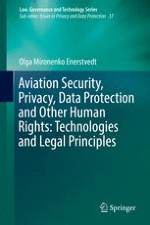2017 | OriginalPaper | Buchkapitel
6. Aviation Security Technologies
verfasst von : Olga Mironenko Enerstvedt
Erschienen in: Aviation Security, Privacy, Data Protection and Other Human Rights: Technologies and Legal Principles
Aktivieren Sie unsere intelligente Suche, um passende Fachinhalte oder Patente zu finden.
Wählen Sie Textabschnitte aus um mit Künstlicher Intelligenz passenden Patente zu finden. powered by
Markieren Sie Textabschnitte, um KI-gestützt weitere passende Inhalte zu finden. powered by
